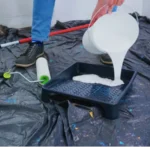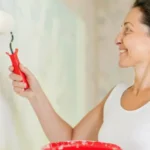
How To Prepare Your House For Exterior Painting?
According to studies, homeowners paint their homes every 7 to 10 years. Painting your home has many benefits as it not only enhances the look and curb appeal of your home but also hides permanent marks and stains and reduces dust and dirt.
This can significantly enhance the real estate value of your home in case you plan on selling your home in the future. You can always hire expert painters in Australia to help you spruce up your home with fresh coats of paint, or you can handle the process independently.
Whichever method you choose, it is important that you first prep your surfaces when you are painting your exteriors. Prepping your home will help get rid of old and loose paint and remove any scratches and wood shingles so that you can apply your new paint on a smooth and even base. Here are some helpful steps to prep your home for exterior painting:
Prep Your Home For Exterior Painting
1. Gather Your Equipment
It is a good idea to arrange all the supplies you need to have everything in one place. Licensed painters in Australia have recommended the following list of supplies that you will need:
• Power or pressure washer
• Garden hose
• Bucket
• Detergent and water
• Safety goggles
• Respirator
• Mask
• Wire brush
• Rags
• Ladder
• Primer
• Drop cloth
• Plastic coverings
• Painter’s tape
• Sander
• Trash bag
Important Tip:
If you are using rollers to paint your walls, here are some expert tips to avoid roller marks on your painted surfaces.
2. Choose The Right Timing
When prepping your home, you must choose the right weather, as inclement weather can wash or dry your paint quickly and thus blister. It is important to choose three weekends for your preparation and painting when the weather is around 50 to 80 degrees Fahrenheit and is dry. If it starts to rain or is humid, you must delay your preparations till the weather improves.
3. Clean The Surroundings
Next, you must protect the area around your exterior surfaces by placing plastic coverings over your floors, plants, and trees. You must also cover any water bodies and mailboxes as well as coverings with plastic wrap or drop cloths. Removing trash cans, grills, and furniture away from your exterior walls is also important so that paint doesn’t fall on these surfaces.
4. Do A Lead Test
If your home were painted before 1978, it most likely would have lead paint, and thus you must proceed with caution. Lead in house paint can become a health hazard over time and is especially harmful to children, pets and pregnant women. Even if your home was built after 1978, you should still get a lead test done to see the level of lead used in your surfaces. If you find that your home has lead paint, then you must:
• Wear a protective suit and an N100 respirator with HEPA cartridges to avoid exposure.
• Avoid sandblasting and dry scraping your walls
• Place plastic coverings all around the home to collect the lead scrapings
• You must not use an open flame near the lead paint.
• Dispose of the paint in sealed garbage bags.
Important Tip:
If you are worried about being exposed to lead, you can hire experienced painters in Australia who will use advanced equipment to prep and paint your home and remove any lead paint carefully.
5. Remove Any Contaminants
Next, you must use a pressure washer or power washer to hose down your exterior and remove dirt and grime. You should start in sections and hose from top to bottom. If your home has softwood siding, you should avoid using a power washer and clean the exterior with detergent and water by hand.
Also, if your surfaces have mould, you should use baking soda and vinegar to remove the mould. In extreme cases, you can mix three parts of bleach with water to get rid of tough mould stains but make sure you wear your mask to avoid inhaling bleach fumes.
Important Tip:
If you have concrete surfaces and walls, it is important that you follow these preparation tips for painting your concrete surfaces.
6. Sand Your Walls
After cleaning and washing your surfaces, you must sand your walls to remove loose paint and rough edges. This will help eliminate any uneven surfaces so that you can easily apply your new paint.
If your surface isn’t bumpy, you should use 80-grit sandpaper, and for rougher edges, it is better to use 100-120 grit sandpaper. Professional painters in Australia suggest you use fine-grit sandpaper around the trimmings and edges of your exterior walls to smoothen rough edges.
7. Fill Gaps And Replace Wood
Once you finish sanding your walls, it is important to repair damaged areas by filling holes with caulk sealants. If your wood is rotting, you should remove it and replace it with finer wood. You should also make sure you remove all the loose paint with a wire brush and work in the direction of the grain to avoid any scratchy surfaces.
Important Tip:
Besides this, it is important to know and reduce any health hazards when painting your walls so that you and your family are safe.
8. Prime Your Exteriors
The last step to prep your walls before painting is to prime them with a light-coloured primer to seal the areas so the paint can go over them smoothly. Primer also provides good coverage if you are changing the colours drastically, as it helps make the painting job easier. You should choose a latex or oil-based primer to help paint your surfaces easily and with a durable finish.
Conclusion
Once you complete the above preparations, you will be ready to paint your exterior walls with fresh coats. Remember to use the dual technique where you can spray or paint your walls, and your friend can then go over the area with a paint roller to smooth the surface.
To help you choose the right paint colour for your walls, you can look at these seven paint colour mistakes to avoid. For a smooth and perfect look, you should hire painters in Australia who are experts in prepping and painting your surfaces to make sure your home looks good.
- 17 Jul, 2025
- 23 Jun, 2025
- 05 May, 2025
- 04 Mar, 2025
- 27 Dec, 2024
We have a proven track record of providing high-quality and customised painting services at the best price. Call us for more details.




